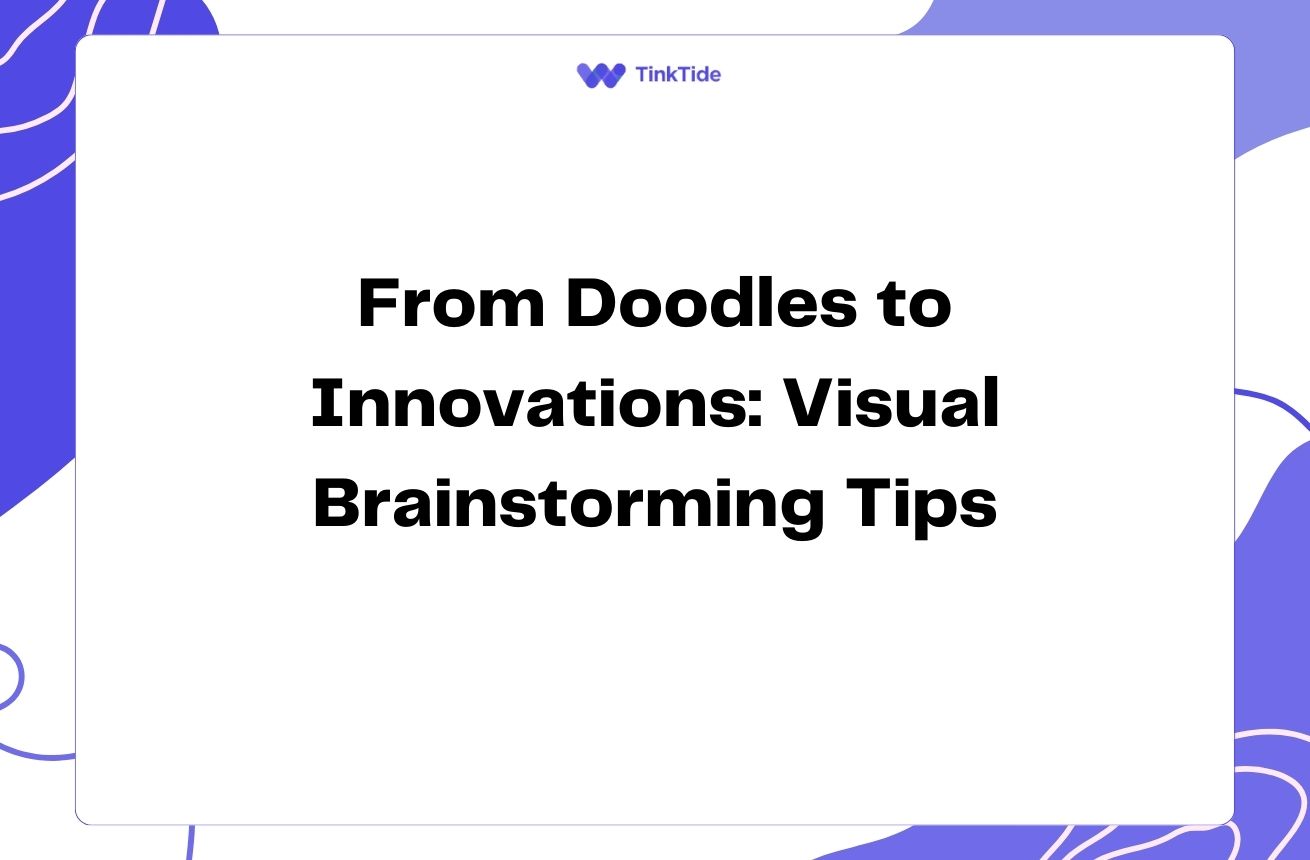Unlock Your Creative Potential with Visual Brainstorming
The Power of Visual Brainstorming
Visual brainstorming is a powerful technique that can significantly boost your creativity and problem-solving abilities. By combining visual elements with traditional brainstorming methods, you can tap into both the logical and creative sides of your brain, leading to more innovative and comprehensive solutions.
Research has shown that visual thinking can enhance memory retention, improve understanding of complex concepts, and stimulate creative thinking. According to a study published in the Journal of Creative Behavior, visual brainstorming techniques can increase idea generation by up to 50% compared to traditional methods.
By incorporating visual elements into your brainstorming sessions, you can create a more engaging and productive environment for idea generation. This approach allows you to see connections between ideas more easily, organize thoughts more effectively, and communicate complex concepts with greater clarity.
Key Visual Brainstorming Techniques
Let's explore some of the most effective visual brainstorming techniques that can help unlock your creative potential:
- Mind Mapping: Create visual diagrams to connect and organize ideas
- Storyboarding: Use sequential images to visualize processes or narratives
- Concept Mapping: Illustrate relationships between different concepts
- Sketching: Use quick drawings to visualize ideas and solutions
- Visual Metaphors: Represent abstract ideas through concrete imagery
Mind Mapping: A Powerful Visual Tool
Mind mapping is one of the most versatile and effective visual brainstorming techniques. Developed by Tony Buzan in the 1970s, mind mapping allows you to create a visual representation of your thoughts and ideas, starting from a central concept and branching out into related subtopics.
To create a mind map, start by writing your main topic or problem in the center of a blank page. Then, draw branches radiating out from the center, each representing a subtopic or related idea. Continue to add smaller branches to these main branches, creating a hierarchical structure of interconnected ideas.
Mind mapping tools like MindMeister or XMind can help you create digital mind maps easily. These tools often include features like real-time collaboration, which can be particularly useful for team brainstorming sessions.
By visualizing your ideas in this way, you can more easily identify patterns, make connections between different concepts, and generate new ideas by exploring different branches of thought.
Storyboarding: Visualizing Processes and Narratives
Storyboarding is a visual brainstorming technique that originated in the film industry but has since been adopted by many other fields. It involves creating a series of images or sketches that represent a sequence of events, ideas, or steps in a process.
To use storyboarding for brainstorming, start by dividing your page into a grid of squares. In each square, sketch a simple image or write a brief description representing a step in your process or an element of your idea. This technique is particularly useful for visualizing user journeys, product development processes, or marketing campaigns.
Tools like Miro or Storyboard That offer digital platforms for creating storyboards, making it easy to collaborate with team members and iterate on your ideas.
By breaking down complex ideas into a series of visual steps, storyboarding can help you identify potential problems, generate new ideas for each stage of a process, and communicate your concepts more effectively to others.
Concept Mapping: Illustrating Relationships
Concept mapping is a visual brainstorming technique that focuses on illustrating the relationships between different ideas or concepts. Unlike mind mapping, which typically has a hierarchical structure, concept maps allow for more flexible connections between ideas.
To create a concept map, start by identifying the key concepts related to your topic. Write these concepts in boxes or circles, and then draw lines between related concepts. Label these lines with words or phrases that describe the relationship between the connected concepts.
Tools like CmapTools or Lucidchart provide digital platforms for creating concept maps, offering features like customizable shapes and colors to enhance your visual representation.
Concept mapping can be particularly useful for understanding complex systems, identifying gaps in knowledge, and generating new ideas by exploring unexpected connections between concepts.
Implementing Visual Brainstorming in Your Workflow
To effectively incorporate visual brainstorming into your creative process, consider the following steps:
- Choose the right technique: Select a visual brainstorming method that suits your specific problem or project
- Prepare your tools: Gather necessary materials (paper, markers, digital tools) before starting
- Set clear objectives: Define what you want to achieve with your brainstorming session
- Encourage free thinking: Don't judge ideas during the initial brainstorming phase
- Iterate and refine: Review your visual brainstorm and build upon promising ideas
Overcoming Common Challenges
While visual brainstorming can be highly effective, you may encounter some challenges when implementing these techniques. Here are some common issues and how to address them:
1. Fear of drawing: Many people feel intimidated by the idea of sketching. Remember that the goal is to communicate ideas, not create art. Simple stick figures and basic shapes are often sufficient.
2. Overwhelm: Visual brainstorming can sometimes lead to an overwhelming number of ideas. Combat this by setting time limits for each phase of your brainstorming session and using techniques like dot voting to prioritize ideas.
3. Digital vs. analog: While digital tools offer many advantages, some people find that physical drawing helps them think more creatively. Experiment with both approaches to find what works best for you.
By addressing these challenges head-on, you can maximize the benefits of visual brainstorming and unlock your full creative potential.
Address common questions
Here are some frequently asked questions about visual brainstorming:
How long should a visual brainstorming session last?
The ideal length can vary depending on the complexity of the problem and the number of participants. Generally, aim for 30-60 minutes of active brainstorming, followed by a review and discussion period. For complex issues, consider breaking the session into multiple shorter segments.
Can visual brainstorming be done remotely?
Yes, many digital tools like Miro, MindMeister, and Lucidchart support real-time collaboration, making remote visual brainstorming sessions possible and effective. Ensure all participants have access to the chosen tool and consider using video conferencing to maintain engagement.
How can I improve my visual thinking skills?
Practice regularly by incorporating sketching into your daily work, trying different visual brainstorming techniques, and studying visual communication principles. Books like 'The Back of the Napkin' by Dan Roam can provide valuable insights and exercises.
Is visual brainstorming effective for all types of problems?
While visual brainstorming can be applied to a wide range of problems, it's particularly effective for complex issues, creative challenges, and situations where you need to explore multiple perspectives. For some highly technical or data-driven problems, other methods might be more suitable.
How many people should participate in a visual brainstorming session?
The ideal group size can vary, but generally, 5-8 participants work well. Smaller groups allow for more in-depth exploration, while larger groups can generate a wider variety of ideas. For larger teams, consider breaking into smaller subgroups for initial brainstorming, then reconvening to share and build on ideas.
Provide additional resources
The Sketchnote Handbook
A comprehensive guide to visual note-taking techniques
Visual Thinking: Empowering People & Organizations through Visual Collaboration
A book exploring the power of visual thinking in business and problem-solving
Miro's Guide to Remote Brainstorming
Practical tips for conducting effective remote visual brainstorming sessions
IDEO's Design Thinking Course
An online course that includes visual brainstorming techniques as part of the design thinking process
Gamestorming
A collection of visual thinking games and activities for innovators and problem-solvers
Unleash Your Creative Potential
Visual brainstorming techniques offer powerful tools for enhancing creativity, generating innovative ideas, and solving complex problems. By incorporating methods like mind mapping, storyboarding, and concept mapping into your workflow, you can tap into the full potential of your visual thinking abilities.
Remember that like any skill, visual brainstorming improves with practice. Don't be discouraged if your first attempts feel awkward or unproductive. With time and experience, you'll develop your own style and discover which techniques work best for you and your team.
Start experimenting with visual brainstorming in your next project or problem-solving session. You might be surprised at the creative solutions and insights that emerge when you give your ideas a visual form.
Supercharge Your Creativity with Tinktide
Ready to take your visual brainstorming to the next level? Try Tinktide's powerful collaboration tools and unlock your team's full creative potential.
Start Your Free Trial

